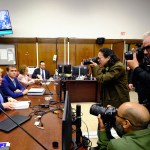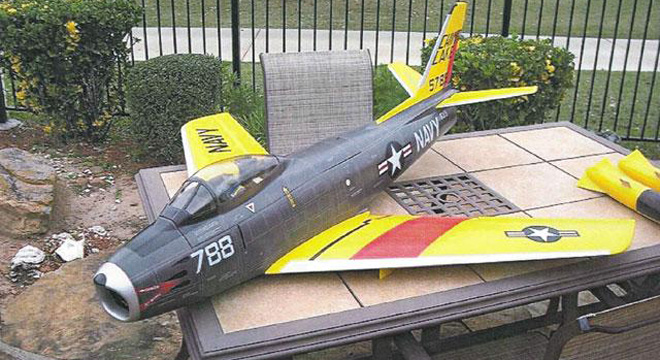Is a six-foot long remote controlled airplane packed with 40 lbs. of C-4 explosives capable of flying? And if it were flown into the Pentagon and the dome of the Capitol building, how much damage could it do?
The FBI seems to think the plot allegedly hatched by a 26-year-old with a Physics degree from Northeastern University is plausible. “Remote controlled aircraft are capable of carrying a wide variety of payloads (including a lethal payload of explosives), can use a wide range of take-off and landing environments, and fly different flight patterns than commercial airlines, thus reducing detection,” FBI Special Agent Gary S. Cacace wrote in an affidavit against accused plotter Rezwan Ferdaus.
The planes Ferdaus was allegedly trying to use were an F-4 Phantom and an F-86 Sabre, according to the FBI affidavit (photos here). They are described as smaller scale versions of U.S. military fighter jets that range from 60 to 80 inches in length and have a wingspan range of 44 to 63 inches.
Ferdaus allegedly changed his plan pretty often, and the biggest obstacle to pulling off his plot would appear to be have been finding a model plane capable of carrying a significant payload. Early on in the plot, he allegedly did research on a library computer where he learned that remote controlled airplanes could carry about 38 to 42 pounds. But during a later conversation in March, Ferdaus allegedly found a website that sells remote controlled aircraft that could fly up to 100 miles per hour and carry a payload of 50 pounds.
At one point, Ferdaus allegedly planned to fly three F-4 Phantoms filled with 16 grenades into the Capitol dome and opposite sides of the Pentagon at the altitude of the 4th floor. He allegedly said he’d detonate the planes three seconds prior to impact, and thought he could “blow the dome to smithereens.” But as Minnesota Public Radio points out, “the manufacturer says the flying weight of the model is 13 pounds, thanks primarily to its very large motor.”
Ferdaus allegedly referenced the F-4 Phantom II pictured on the website scalercmodels.com, which he said was capable of speeds of up to 160 miles per hour.
As his plot developed, Ferdaus appears to have scaled back the weight of the payloads he believed the planes were capable of carrying, writing that they “have a payload capacity of 10-12 lbs., and thus it is deemed to contain 16 handhelds [grenades] in each,” according to the affidavit. He allegedly planned to launch the planes from Eastern Potomac Park.
Ferdaus allegedly worked with an unnamed plane distributor in Florida, who he told he was purchasing the planes for his son (he’s unmarried and doesn’t have any children). After an undercover FBI official posing as a member of al Qaeda gave him $4,000 in cash, Ferdaus allegedly deposited the money into his bank account and transferred it into a PayPal account under the alias of “Dave Winfield.”
During a meeting in July, Ferdaus allegedly settled on having the planes carry just 5 lbs. of C-4 each (here’s a video allegedly showing what five lbs. of C-4 looks like upon explosion). Wednesday, when the undercover FBI agents delivered 25 lbs. of C-4 explosives (just 1.25 lbs. of which was apparently real), 3 grenades and six fully automatic AK-47 assault rifles to Ferdaus, he was arrested.
Even if he had somehow gotten a plane capable of carrying 40 lbs. of explosives, Paul Worsey, a professor of explosives engineering at Missouri University of Science and Technology, told TPM that one of the model planes would have to fly in though a window to do any real damage.
“It would affect a few offices, but it’s not going to be anything like 9/11,” Worsey said of an explosion with 40 lbs. of C-4. “Most of the Pentagon has been ungraded anyway.”
“The Capitol dome, I don’t know, but I’d guess if they flew it into the dome itself it might collapse it,” he said. “Damage would be localized damage. It will do a lot of damage, but it’s all going to be in one spot.”
Late Update: The AP concurs, a model airplane attack is a longshot:
Counterterrorism experts and model-aircraft hobbyists said it would be nearly impossible to inflict large-scale damage of the sort Ferdaus allegedly envisioned using model planes. The aircraft are too small, can’t carry enough explosives and are too tricky to fly, they said.
“The idea of pushing a button and this thing diving into the Pentagon is kind of joke, actually,” said Greg Hahn, technical director of the Academy of Model Aeronautics. […]
James Crippin, an explosives and anti-terrorism expert, said that much C-4 could do serious damage — a half-pound will obliterate a car. But he said getting a stable explosive like C-4 to blow up at the right time would have been hugely difficult.
And there were slim prospects of causing any serious damage to buildings like the Pentagon and Capitol, which are undoubtedly hardened to withstand explosions, according to Crippin, director of the Western Forensic Law Enforcement Training Center.
“Basically, I think he’s suffering from delusions of grandeur,” he said.









